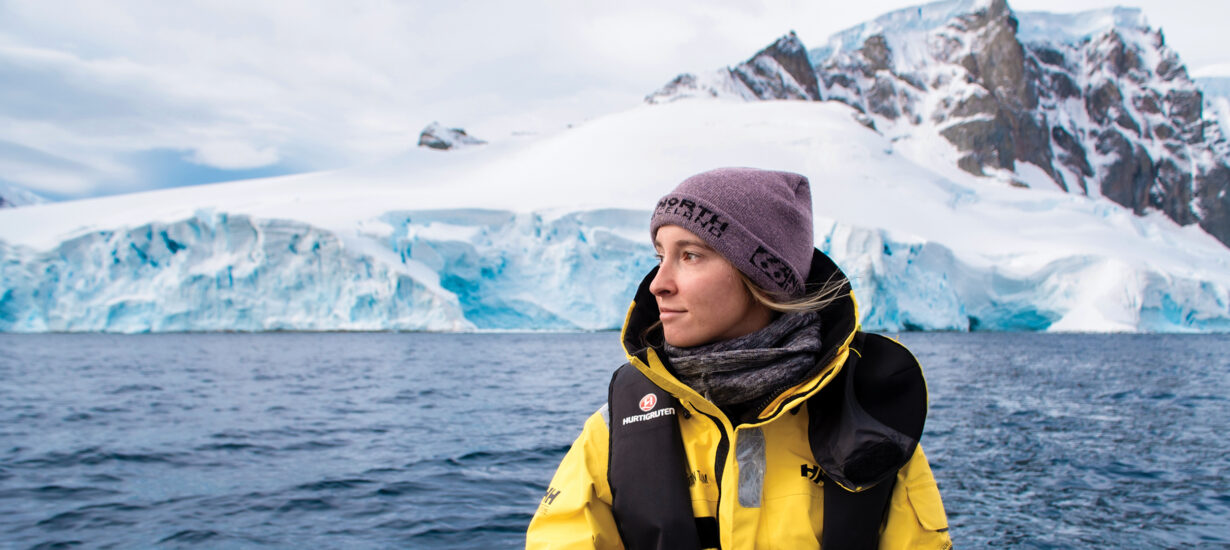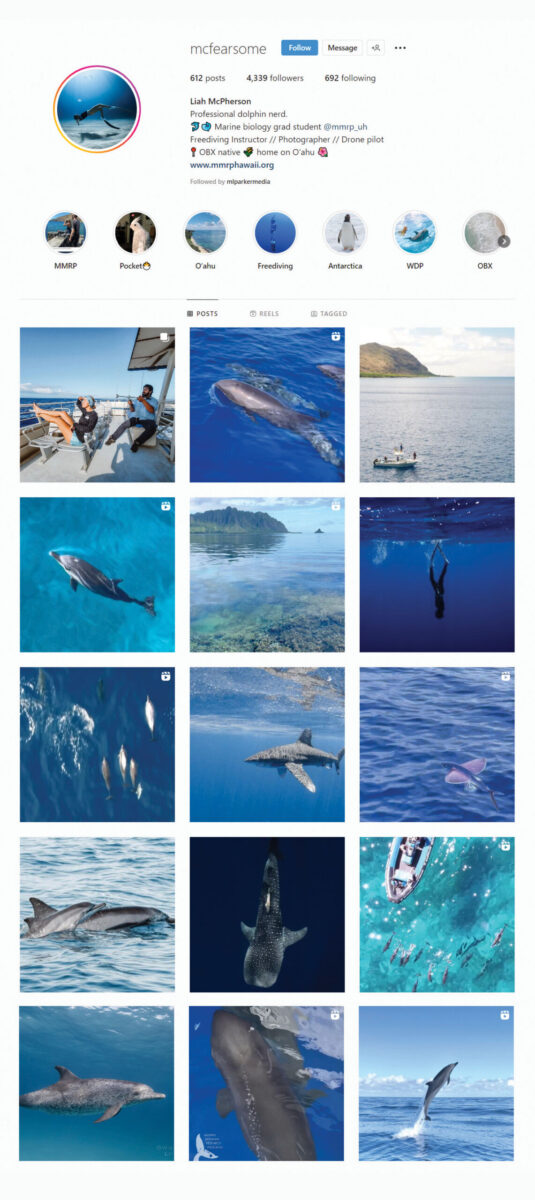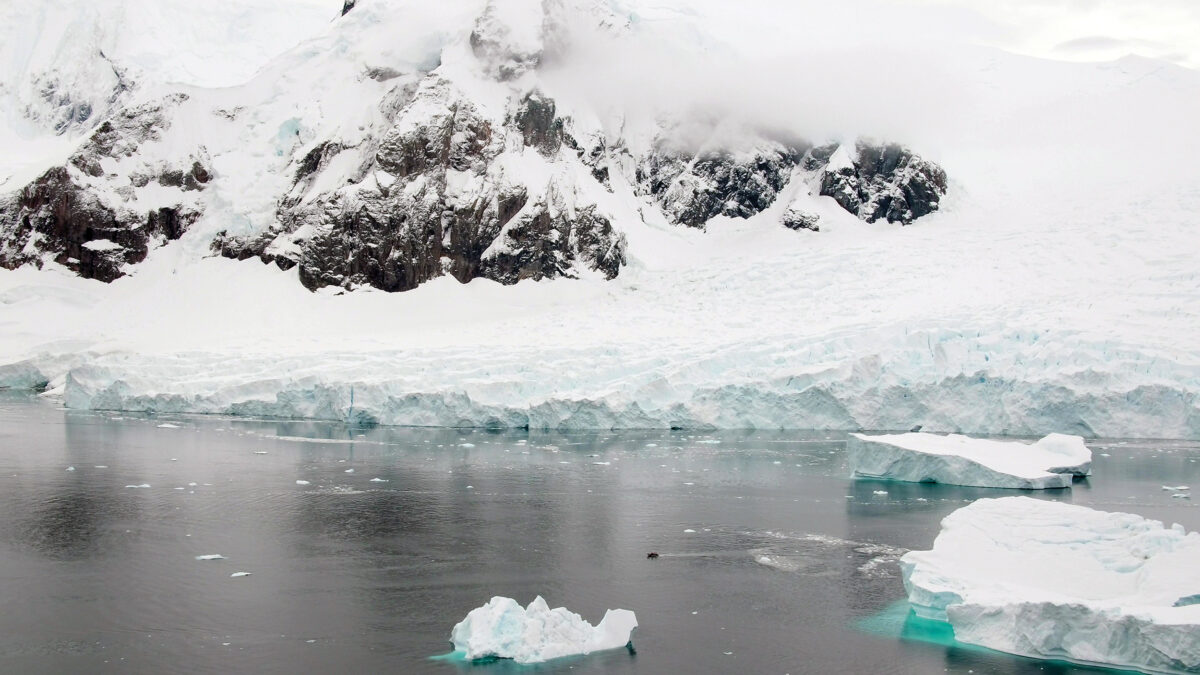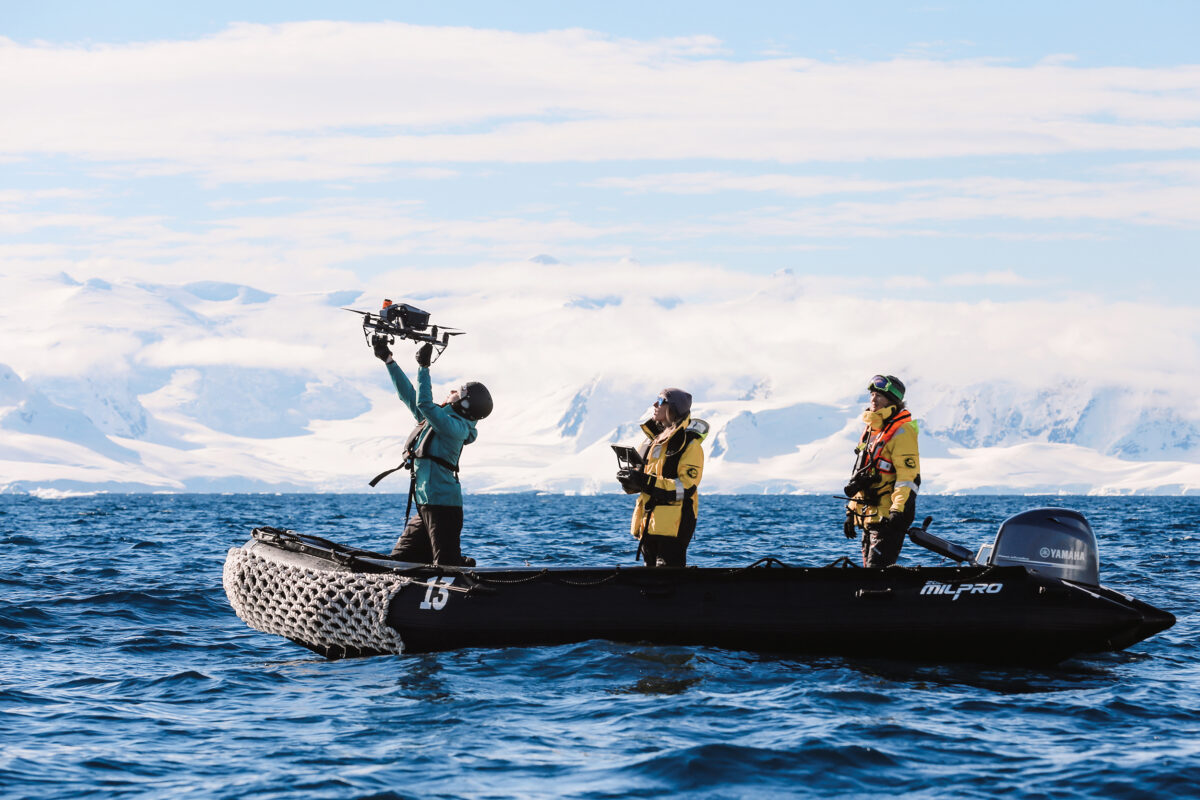Revel in the Deep Blue Sea

From Antarctica to Hawaii, Liah McPherson ’19 has marine photography down to a science.
By Alyssa LaFaro

McPherson’s Instagram page: @mcfearsome
The Instagram page for Liah McPherson ’19 looks like an adventurer’s dream. It overflows with pictures of dolphins and beaches, whales and oceans, penguins and icebergs. Occasionally you see a few shots of McPherson, showing off her giant smile. In one, she stands on the bow of a ship covered in snow. In another, a volcano erupts behind her. Many show her floating in the middle of the ocean, perfectly at peace and surrounded by hues of blue, practicing one of her favorite sports: free diving, deep-water diving without a breathing apparatus.
“Earth is crammed with heaven,” reads the caption on her picture of Oahu’s South Shore during golden hour.
As a second-year master’s student in the marine biology graduate program at the University of Hawaii at Mānoa, McPherson studies a population of spinner dolphins on the west side of Oahu. She uses DSLR (digital single-lens reflex) photography and a drone to assess how many there are and their ages.
She admits that field work is not always photogenic, and it often includes completing purchase orders for equipment and various other “things that make me want to pull my hair out,” she said. But this project in Hawaii is the first one she can take full ownership of — and that’s what makes it truly beautiful.
“I have done it all,” she said. “From designing the research methodology, to coordinating with the marina, to finding and training my own interns to help me out, to driving the boat. It’s not just collecting and analyzing data; it’s all the setup and logistics. That was all new to me and challenging at first. But now it feels really good to know I can create and execute a project.”
In February 2022, McPherson took that experience to Antarctica, where she spent six weeks helping a research team fly drones over whales to collect data.
She got to all of these places with a dual degree in biology and animal behavior and a minor in marine science from Carolina.
When McPherson was a teenager, she inherited a camera from a family friend and began experimenting with it. “I was discovering this love for photography and seeing how it could actually be used for science,” she said.

Photo: Liah McPherson ’19
A love for cameras and dolphins
McPherson doesn’t know exactly when or how her obsession with dolphins began. But when she was a small child, she began drawing pictures of the underwater mammals, even though she grew up nowhere near them in snowy Syracuse, New York — a land of freshwater lakes, not the saline-rich oceans cetaceans prefer.
When she was 8, her parents moved the family to the Outer Banks. At age 14, she began volunteering with the Outer Banks Center for Dolphin Research, where she first learned how photo identification is used to monitor dolphins. Around the same time, she inherited a Nikon D300 from a family friend and began experimenting with photography. “I was discovering this love for photography and seeing how it could actually be used for science,” she said.
But what really changed McPherson’s life was a book: Dolphin Diaries, by Denise Herzing. Herzing leads the Wild Dolphin Project, a nonprofit scientific research organization that studies and reports on a specific pod of free-ranging Atlantic spotted dolphins in the Bahamas.
McPherson was so inspired by the book that she applied to be an intern with the project and began working with the team when she was a junior in high school. Just before McPherson’s junior year at UNC, Herzing invited her to be a field assistant for the summer season.
McPherson combined her love for dolphins with her research at Carolina. First, she learned about the scientific process while working in Associate Professor Adrian Marchetti’s phytoplankton lab during her first and sophomore years. Then, under the guidance of biologist Catherine Lohmann, she completed a senior honors thesis on the effectiveness of drones for studying dolphin behavior. She also used the interdisciplinary studies option to craft a second major for herself in animal behavior. “All of the people at UNC were always supportive of what I wanted to do and even made exceptions for that sometimes, which was great,” McPherson said.
In the spring of her senior year, for example, one of the Wild Dolphin Project dolphins became stranded and required rehabilitation. The release of the animal back into the wild was scheduled during the middle of the semester, but it was important for McPherson to help — and she was able to with encouragement from her professors. She missed classes for a week so she could fly to the Bahamas to assist. “My professors were really understanding,” she said. “They knew it was important for me to be part of this research and release effort.”



![ McPherson: “One of my favorite parts of working in Antarctica was working with Chloe [Lew, pictured] and Kiirsten [Flynn]. … It didn’t even register with me that we would be operating as an all-woman team, but with each passing day of fieldwork, I got more stoked on it. I received plenty of surprised looks and comments when I told people I was A) a drone pilot, B) learning to operate a crossbow to collect biopsy samples, and C) traveling to Antarctica alone. Don’t get me wrong, most people are supportive, and for that I’m appreciative — but the underlying sexism is also apparent. So the opportunity to do good science with two totally badass women in one of the harshest environments on Earth was encouraging to say the least.” Photo: Kiirsten Flynn/Courtesy of Liah McPherson ’19](https://alumni.unc.edu/wp-content/uploads/cache/2023/01/JF23_mcpherson_antarctica_raft_2/2473317583.jpg)





Chloe Lew catches the drone that McPherson, center, has just flown to photograph whales. Photo: Leslie Hsu Oh
The art of flying drones
The spinner dolphins that live on the west coast of Oahu are “basically famous,” according to McPherson, who explained that people come from all over the world to see and swim with them. But as you can imagine, the human interaction affects the population — which researchers don’t actually know much about.
There’s little data on the number of dolphins that use the coastline, the health and ages of the population, and their distribution around the island. That’s where McPherson comes in. As a graduate student within the Marine Mammal Research Program at the University of Hawaii at Mānoa, she’s spent the last two years photographing the pod with drones and DSLR cameras to collect this information.
Flying drones is a challenge, and to do so for research requires a Federal Aviation Administration commercial license. Flying drones from a boat takes even more skill. The pilot must consider swell, wind speed and direction, as well as assistance from another person to get the drone into and out of the air. Typically, a person stands at the bow or stern, holding the drone over his or her head — and wearing a helmet for protection — while the pilot mans the controls to launch it. Clear communication is essential for a successful takeoff and landing.
McPherson first saw someone use a drone while interning with the Wild Dolphin Project, when one of the project’s collaborators brought one out for a day on the boat.
“I remember seeing the videos they got and thinking, Wow, this is such a cool perspective,” she said. “Then I started looking at papers. People were just starting to use drones at that time, and I thought it was pretty untapped and no one was doing it with these dolphins in the Bahamas. So I figured I should get in on it.”
In October, McPherson completed her final field season for her master’s degree. Thanks to “fantastic weather and lots of spinner dolphin sightings,” she’s deep in analysis mode, synthesizing the data from her eight field seasons.

McPherson photographs dolphins off the coast of Oahu for her master’s project. Courtesy of Liah McPherson ’19. Photo taken under NMFS permit 21476
Aloha from Antarctica
McPherson’s experience with drones has launched her a long way from home. Not only did it help her with acceptance into her graduate program, but it became her ticket to join a research expedition to Antarctica.
In June 2021, McPherson’s adviser from the University of Hawaii at Mānoa, Lars Bejder, asked whether she’d like to go to Antarctica in February 2022 to fly drones over whales to contribute to a long-term dataset on whale health and population. “I was like, What?” she said with a laugh. “I kind of freaked out. Between then and a few months ago, I never really knew if it was going to happen. But it did.”
This past spring, she spent six weeks aboard an expedition cruise line called Hurtigruten, working with scientists from the California Ocean Alliance. Whenever the cruise ship stopped to let guests adventure on land, McPherson and two other COA scientists would hop in a boat and head out into nearby waters to conduct their research.
McPherson and her teammates — Chloe Lew, an acoustician with COA, and Kiirsten Flynn, a research biologist with Cascadia Research Collective — quickly learned how a beautiful Antarctic day could turn deadly in a matter of minutes. “There were days we could go out where it was nice and calm. And then within 10 minutes it’s whiteout conditions,” McPherson said.
Flying a drone from an inflatable raft in the middle of the Antarctic was a wake-up call. It is immensely cold and incredibly unstable. On a few occasions, McPherson launched her drone in windier conditions than she liked, forcing herself to ignore its high-wind warnings the entire flight.
Nevertheless, she and her team succeeded. They collected data on 34 groups of whales, measured body conditions for 18 individuals and obtained 11 biopsy samples.
McPherson returned to Hawaii a stronger scientist. Not only is she a better drone pilot, but she learned how to collect biopsy samples from marine mammals — a skill she can utilize for whale research in Hawaii.
“My favorite thing about my research is that I get to merge my blend of hobbies — photography, videography, flying drones, driving boats — and do something that I love,” she said. “And Carolina helped with that.”
McPherson plans to defend her master’s thesis this summer. She then hopes to pursue her PhD in Hawaii — and to return to Antarctica to collect preliminary data for that research. But before she dives into that phase of her life, she’d like to take a year off to publish the research from her master’s program and travel. Newly armed with her free-diving instructor’s certification, she’d like to start teaching the sport to the next generation of free divers in between adventures and field work.
Sounds like she’ll have plenty of fodder for her Instagram page.
Alyssa LaFaro is editor of UNC’s Endeavors magazine, in which this article originally appeared.
Thanks for reading the Carolina Alumni Review
Carolina Alumni members, sign in to continue reading.
Not yet a member? Become one today.







